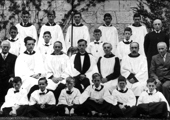Christ Church Brockham
Extracts from The Birth of a Parish
by Katie Dodson
The earliest recorded place of worship in Brockham was a chapel in the home of John FitzAdrian, who was granted a licence for it by the Bishop of Winchester in 1254. It is not known where this house was but that there was a private chapel in Betchworth Castle in 1487.
In pre-Reformation days the villagers of Brockham worshipped at St. Michael's Church Betchworth, where there has been a church on the present site for 900 years. The south aisle chapel always had connections with Brockham and there is a memorial to Gabriel Wight, whose family were Lords of the Manor of Brockham for 200 years from 1605. It became known as the Hope Chapel after Henry Thomas Hope bought the Manor in 1838.
Brockham Manor was one of the four included in the parish of Betchworth, the others being East Betchworth, Wonham and Aglond Manor. In 1816 the manor of East Betchworth was bought by the Rt. Honourable Henry Goulburn who represented Cambridge University in Parliament for more than 20 years. He filled the offices of Secretary of Ireland, Secretary of State and Chancellor of the Exchequer. His eldest son, also Henry, a Fellow of Trinity College, Cambridge, and a barrister, died in 1845, aged 30. For many years it had been his earnest desire to erect a church at Brockham Green. He had collected a considerable sum for this purpose and his friends decided to complete his plan as a memorial to him.
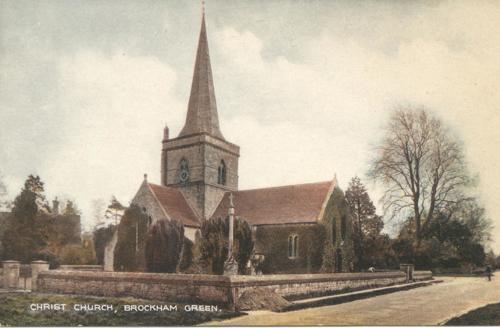
The site was given by Henry Thomas Hope and the architect was Benjamin Ferry, a pupil of Pugin. The architect said: "At the time the church was built there was much discussion in the committee whether brick or flint or local stone should be the materials, but an offer being made by Sir Benjamin Brodie to give all the stone required for the walls, and it was felt to generous an offer to be rejected. Every possible care was taken to select the best stone and an immense quantity was set aside as unfit for use."
At this time Sir Benjamin was living at Broome Park in Betchworth, and his estate extended to the top of Box Hill and included quarries.
Christ Church Brockham was consecrated by the Bishop of Winchester on 12th January 1847.
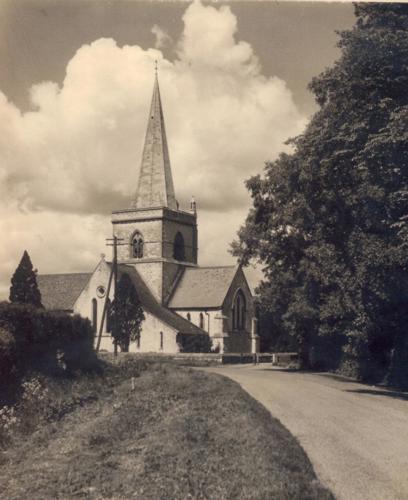
Henry Thomas Hope provided the first church clock. It had originally belonged to Betchworth Castle which Mr Hope had purchased and dismantled in 1834. The clock had to be repaired in 1900 at which time the "movement was about 100 years old". The old clock had a history of trouble and £94 was collected for repairs and a new bell in 1848. The service bell in use today was the hour bell of the first clock and it was retained as a swinging bell when the carillon was installed in 1936. The present electric clock was provided by public subscription in 1936 and its dials were re-guilded in 1977 in celebration of the Queen's Silver Jubilee.
The Vicarage, now known as Anthony West House was built by public subscription in 1855. The site cost £240 and the house £1218, the garden wall £58 and £45 was spent on fencing.
In 1861 the population of Brockham was 761 and there were 160 houses.
In 1875 the organ, "which had not been functioning well, was in a dirty state, with accumulated dust interfering with the proper speech of the pipes". The repairs cost £160 and took three months. Only three years later damp caused further problems. A new organ chamber and vestry were built and hot-air apparatus installed at a total cost of £250.
In 1877, the choir was run by Mrs Cheales, the Vicars wife. She was to hold this position for 14 years. The choir boys were paid 9s per year, had to attend church twice on a Sunday, attend a practice on a Thursday and if the were absent one penny was deducted from their pay!
The income of the church and partly that of the Vicar was drawn from pew rents, which in 1878 amounted to £59, one half of the sittings had, by law to be free and too be "as advantageously situated with regard to position and convenience as those for which a rent may be fixed and received".
The Pew Opener's salary was £8 per annum, for which he had to attend church on Sundays and other services, to light and attend the fire, stoves and candles and to wind and take charge of the clock.
In 1883 the church was in need of "massive restoration". The defective condition of the exterior of the building was due to the perishable nature of the local stone. The decayed portions had to be removed and replaced with Bath stone. The costs of repair to the tower and buttress cost £400 and the restoration of the rest of the stone £600.
Also in 1883 the white marble memorial stone to Henry Goulburn was inserted into the front of the north porch by his younger brother Col. Edward Goulburn.
Among old furnishings "a beautiful and costly communion table, a velvet altar cloth worked by herself and communion linen" were given by Miss Goulburn in 1860. In 1875 the five daughters of Sir Benjamin Brodie of Brockham Warren, presented kneeling cushions, worked by themselves, for use at the communion table rail.
The stone and delicately carved pulpit, costing £34 2s, was dedicated in 1889. In the same year a brass and oak communion rail was fitted at a cost of £14 3s.
In 1890 Mr Kempe gave the stone cross above the porch. The brass lectern is dated 1893 and is in memory of Henry Bowman.
In 1931, Mr H.R Kempe had been a church warden for 42 years, Lay Reader for 16 years and Chairman of the Parish Council for 35 years, and was about to celebrate his golden wedding. To mark the occasion the choir stalls were provided by public subscription and fitted in his honour.
Also in 1931 the priest's stall was presented in memory of the Revd. A.E. Cooke, Vicar of Brockham from 1921-1929.
In 1934 the installation of electric light commemorated the twenty-eight strenuous years spent as G.P by the "much loved" Dr Thorne.
The Sidney Poland bequest to the church provided for an octave of bells. the largest weighing 7 cwt and the total weight is 28cwt.
A further £250 of Poland's bequest was spent on the lych gate. Designed by local architect Frederick Hagyard, it contains four tons on English Oak and rests on a base of Cotswold stone. Among the village craftsmen who worked on it were the names Risbridger, Monnery, Jordan and Cornwell.
In 1950 the Vicarage paddock and orchard were taken over by Surrey County Council, by compulsory purchase, to provide a playing field and a site for the school canteen and dining hall.
link to more about the Vicars of Brockham
link to Anthony West House
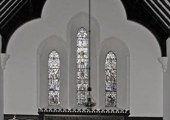
Memorial Windows in Christ Church Brockham Green
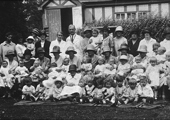
Church Hall
